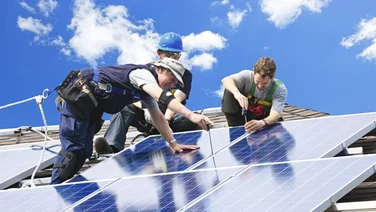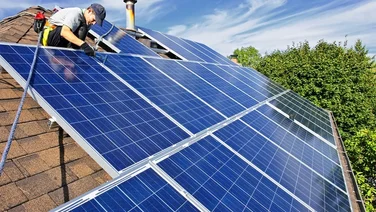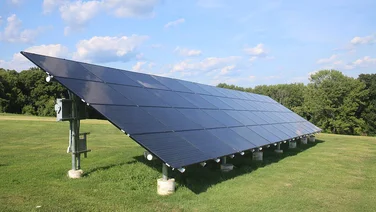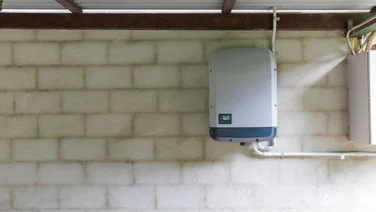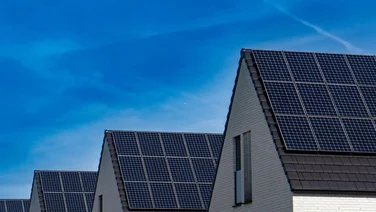- What is a flexible solar panel?
- When should you use flexible solar panels?
- How much do flexible solar panels cost?
- How do flexible solar panels work?
- Pros and cons of flexible solar panels
- Best flexible solar panels
- How long do flexible solar panels last?
- How do you clean flexible solar panels?
- Summary
- Flexible solar panels cost £200-£300 per square metre
- They can bend by around 30 degrees, and sometimes more
- Flexible solar panels can be used for motorhomes and boats
Solar panels are the future, and there are plenty of different types of solar panel to choose from if you’re looking to save money and reduce your carbon footprint.
They’re a powerful force in the fight against climate change, the Smart Export Guarantee means you can now save even more money on your energy bills, and the cost of solar panels is plummeting.
But sometimes, traditional panels won’t do the trick. Sometimes they’re too rigid for the curved roof of your house or caravan, or too heavy for the roof of your holiday cottage.
That’s where flexible solar panels come in. They’re light, adaptable, and won’t affect the aesthetic qualities of the home or vehicle they’re attached to.
To see the excellent deals you could get on solar panels, fill in this form and receive the best quotes around.
Where do you want to install solar panels?
Get started
What is a flexible solar panel?
Flexible solar panels are thinner, lighter, and more versatile than standard solar panels, capable of bending around a corner or over a bump in your roof.
That’s because they’re made of much less substantial silicon sheets than their heavier cousins.
While a standard panel’s thickness is around 200 micrometres (0.2 millimetres), flexible solar panels can come in at just a few nanometres. That’s 10,000 times thinner than a human hair.
They’re not quite as light as a hair, but at somewhere between 0.8kg and 3kg, none of them are heavier than a Chihuahua.
When should you use flexible solar panels?
They’re great for off-grid, on-the-move applications – like camping holidays, or for powering your boat – because they’re light and can wrap around pretty much any shape. You can even use these solar panels for a campervan or caravan.
Why bring expensive, carbon-emitting oil with you on a trip, when the sun is right there above you?
We don’t recommend them for home use – standard models are around twice as efficient as flexible solar panels, at least for now – but if you want to power your life while you’re travelling through the natural world, they’re your best option.
And if your roof is too lightweight to hold up several 40-pound panels, flexible solar panels could still be the answer to your renewable dreams.
They may not be as efficient as traditional panels, but when you consider the cost of solar panels has fallen by over 80% since 2010, they may still be worth it.
Plus, solar panels can increase the value of your property. According to our latest National Home Energy Survey, 69% of Brits say they are ‘likely’ or ‘very likely’ to buy a property with solar panels on it, up from 65% last year.
Where do you want to install solar panels?
Get startedHow much do flexible solar panels cost?
The cost of flexible solar panels will depend on whether they’re being used to power a house or a vehicle. To help, and give you a better idea of what you can expect to pay, we’ve broken down the cost by roof size and by vehicle size in the sections below.
By roof size
Flexible solar panels will typically cost you £200-£300 per square metre.
Fortunately, this means they’re often cheaper than other panels, usually because they require less material in the manufacturing process.
Unfortunately, you’ll generally need at least 30 of them to power your household, meaning you’ll probably run out of roof space before it becomes worth it.
For instance, it takes 30 Renogy RNG-100DB-H 100W panels to create a 3kW solar PV system, which can supply the amount of power typically used by a family of three.
But instead of the 20m² of roof needed for traditional panels, these panels require 29.8m². That’s nearly 50% more roof space.
Largely due to this flaw, it’s more difficult to find an installer with the necessary Microgeneration Certification Scheme qualification to set up flexible solar panels on the roof of your house.
But if you have a curved roof, or a cabin in the woods which isn’t able to support regular, heavy panels and has low energy requirements, then flexible solar panels may be perfect for you.
By vehicle
Whether your vehicle goes by land or by sea, you’ll pay around £280 for a 160W panel that covers 1m². When it comes to energy per square metre, that means flexible solar panels won’t produce enough electricity to power your boat, caravan, or car by themselves.
“Flexible solar panels are enough to keep a vehicle going in a garage for a week, but not if you’re touring Europe with an electric shower.”
– Jacques, Select Solar
So at that point, it’s all about getting as much cheap, renewable energy as you can before you have to resort to dirty, polluting petrol.
An installer will size up your vehicle, and tell you how many flexible solar panels it can take.
Alternatively, if you want to receive quotes for traditional solar panels from local experts, just fill in this form.
Savings per year
You could save £43.78 per month if you use four flexible solar panels to fuel the electricity you use in your motorhome, instead of LPG (liquefied petroleum gas).
However, considering that only about 85% of a solar panel’s energy capacity is fulfilled, you’d need five 160W panels to meet this 608kWh energy requirement, which would set you back around £1,120.
This means it would take 26 months of using your motorhome to break even on your flexible solar panel purchase.
But if you use your motorhome enough, it’s definitely worth making the switch.
Plus, there are very few off-grid energy options when you want to power a scenic getaway in the mountains, or the various electrical appliances in your motorhome – and most of these power sources emit a staggering amount of greenhouse gases.
So as well as financial savings, you’ll also play your part in saving the environment.
Want to learn more about the price of solar panels and how much they can save you? Head to our page on Solar Panel Costs.
How do flexible solar panels work?
Though they work in much the same way as standard panels, there are some key differences.
There are two types of flexible solar panels: thin-film panels, and crystalline silicon panels.
Thin-film panels are created by printing photovoltaic material onto one of any number of surfaces, whether it be glass, metal, or even fabric.
This makes it the more flexible type of panel, with a level of bend and versatility that means it can be used to power countless different objects and situations.
Flexible crystalline silicon panels are more common than their thin-film counterparts.
They’re made by taking the crystalline silicon used for standard panels and cutting it until it’s incredibly thin, so it can bend about 30 degrees to wrap around objects which standard panels can’t handle.
These panels are less flexible than the thin-film alternative, but are cheaper and more energy efficient.
Do I need an air gap for flexible solar panels
You do not necessarily need an air gap – a gap between the panel and the surface they are laid on – for flexible solar panels, since they are designed to be laid flat against a surface and bend with it.
However, with no air gap, the panels can heat up a lot on hot days, which can make them less effective.
If you want to avoid this loss of efficiency on hot days, you can create an air gap for flexible solar panels using mounting equipment.
Pros and cons of flexible solar panels
- Can wrap around practically any shape
- Lighter than standard panels
- They’re harder to see, and people can’t steal what they can’t see
- More expensive than regular panels
- Much less efficient
- Not suitable for houses or any system on the grid
- Less durable
Best flexible solar panels
1. BougeRV ISE020N 100W
2. ALLPOWERS AP-SP18V 100W
3. Renogy RNG-100DB-H 100W
4. GIARIDE 100W
5. SUAOKI 150W
6. Richsolar 100W ETFE
7. WindyNation 100W
How long do flexible solar panels last?
Flexible solar panels generally last 5-10 years.
This is a considerably shorter lifespan than traditional panels, which typically have 25-year warranties, and can often last even longer.
However, companies are pumping a lot of money into trying to make flexible solar panels more durable, so they can compete with standard models.
Flexible solar panels are typically more fragile than standard rigid ones. Because they are designed to be thin and flexible, they aren’t protected by sturdy glass or held by a metal frame the way standard rigid panels are.
This makes them more vulnerable to damage, and is why most warranties for flexible panels are only 5-10 years, compared to 25 years for rigids panels.
Most flexible solar panels are waterproof, or water resistant at the very least. That being said, it’s not recommended to submerge them in water for long periods of time.
But you can rest assured that they won’t be damaged by things like rain, or sea-spray. In fact, cleaning your flexible solar panels with water is usually the best way to keep them clean and to ensure they keep working efficiently.
How do you clean flexible solar panels?
Wash your flexible solar panels with good, old-fashioned fresh water and soap.
This should remove any dust, bird droppings, or general debris that the outside world can inflict on your panels to make them less effective.
If your flexible solar panels reside on a boat, this cleaning will also wash away salt water deposits, which can gather and block the sun’s precious rays.
Be careful, though – there’s always a chance that when you’re freshening up your flexible solar panels, you might cause wear and tear.
To reduce the chances of this happening, don’t turn to abrasive materials or substances to clean the panels – even if they’re greasy. Use methylated spirit instead, and preserve your machine’s flawless surface.
If your panel is looking a little tired or beaten up, consider hand-polishing it. Many polishes can even remove fine scratches, which is invaluable when every solar cell counts.
Summary
Flexible solar panels are perfect for those rare occasions when you go off-grid and want a renewable source of energy to keep you going – or to at least reduce your impact on the climate.
Otherwise, it’s best to stick with traditional panel systems – at least for now. If you want to learn more, check out our solar panel A-Z.
Laboratory tests have shown flexible panels performing better than the best polycrystalline panels, and though this technology is still in development, it does show how futureproof the solar industry is against crises like coronavirus.
For the best quotes on traditional solar panels from local professionals, fill in this quick form and invest in your brighter, renewable future.


